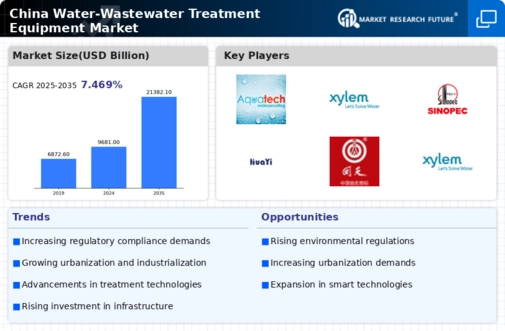Increasing Urbanization
The rapid urbanization in China is a crucial driver for the water wastewater-treatment-equipment market. As cities expand, the demand for efficient wastewater management systems intensifies. Urban areas are projected to house over 70% of the population by 2030, leading to increased wastewater generation. This surge necessitates advanced treatment technologies to ensure compliance with environmental regulations. The market is expected to grow significantly, with investments in wastewater infrastructure reaching approximately $100 billion by 2025. Consequently, manufacturers are focusing on developing innovative solutions to cater to the growing urban population's needs, thereby enhancing the overall efficiency of wastewater treatment processes.
Rising Environmental Awareness
There is a growing awareness of environmental issues among the Chinese populace, which significantly impacts the water wastewater-treatment-equipment market. As citizens become more conscious of pollution and its effects on health, there is an increasing demand for effective wastewater treatment solutions. This trend is reflected in the rising investments in treatment technologies, with the market projected to grow at a CAGR of 8% from 2025 to 2030. Companies are responding by developing eco-friendly equipment that minimizes environmental impact while maximizing efficiency. This shift towards sustainable practices is likely to drive innovation and competition within the market.
Industrial Growth and Regulation
The rapid industrial growth in China has led to an increased focus on wastewater management, thereby influencing the water wastewater-treatment-equipment market. Industries such as manufacturing, textiles, and chemicals generate substantial amounts of wastewater, necessitating effective treatment solutions. Stricter regulations imposed by the government to control industrial discharge have further propelled the demand for advanced treatment technologies. By 2025, it is estimated that the industrial sector will account for over 60% of the total wastewater generated, creating a significant market opportunity for equipment manufacturers. This trend indicates a shift towards more sophisticated treatment systems that comply with regulatory standards.
Government Initiatives and Funding
Government initiatives play a pivotal role in shaping the water wastewater-treatment-equipment market. The Chinese government has implemented various policies aimed at improving water quality and promoting sustainable practices. For instance, the 13th Five-Year Plan emphasizes the importance of wastewater treatment, allocating substantial funding for infrastructure development. By 2025, it is anticipated that the government will invest over $50 billion in wastewater treatment facilities. This financial support encourages private sector participation and innovation, leading to the development of advanced treatment technologies. As a result, the market is likely to witness a surge in demand for equipment that meets stringent regulatory standards.
Technological Advancements in Treatment Processes
Technological advancements are transforming the water wastewater-treatment-equipment market in China. Innovations such as membrane bioreactors, advanced oxidation processes, and smart monitoring systems are enhancing treatment efficiency and reducing operational costs. The integration of IoT and AI technologies is enabling real-time monitoring and management of wastewater treatment facilities, leading to improved performance and compliance with environmental standards. As these technologies become more accessible, the market is expected to expand, with a projected growth rate of 10% annually through 2030. This trend suggests that companies investing in R&D will likely gain a competitive edge in the evolving landscape of wastewater treatment.






















Leave a Comment